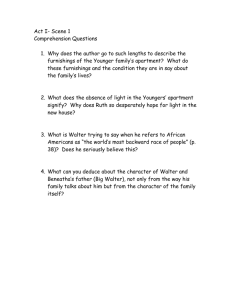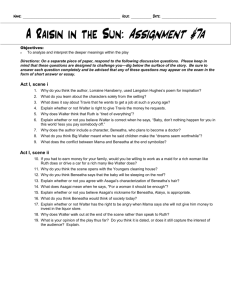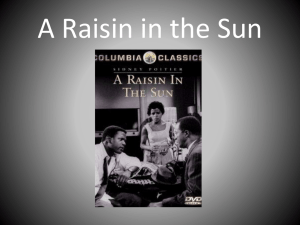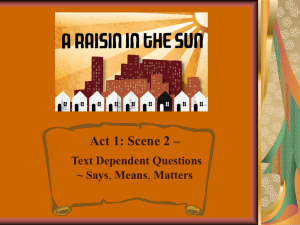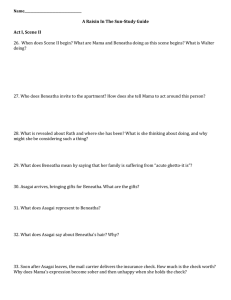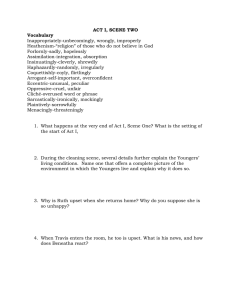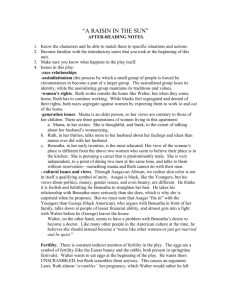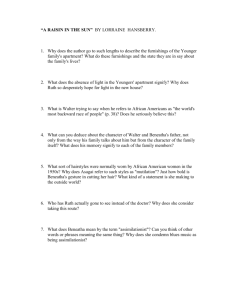A Raisin in the Sun Handout
advertisement
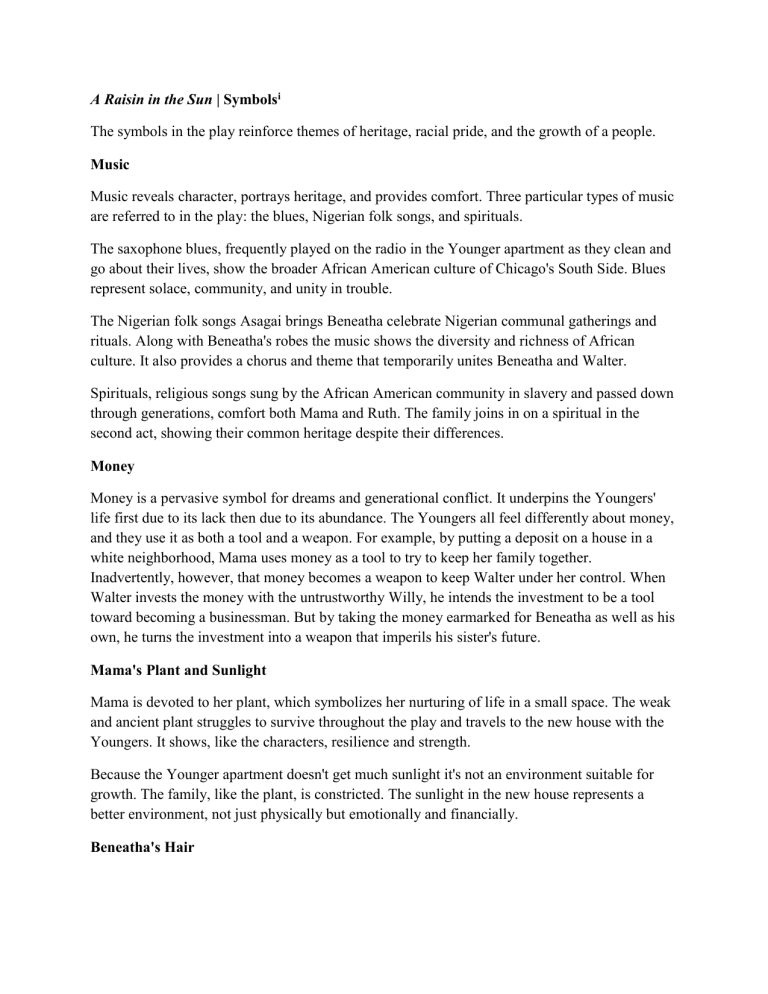
A Raisin in the Sun | Symbolsi The symbols in the play reinforce themes of heritage, racial pride, and the growth of a people. Music Music reveals character, portrays heritage, and provides comfort. Three particular types of music are referred to in the play: the blues, Nigerian folk songs, and spirituals. The saxophone blues, frequently played on the radio in the Younger apartment as they clean and go about their lives, show the broader African American culture of Chicago's South Side. Blues represent solace, community, and unity in trouble. The Nigerian folk songs Asagai brings Beneatha celebrate Nigerian communal gatherings and rituals. Along with Beneatha's robes the music shows the diversity and richness of African culture. It also provides a chorus and theme that temporarily unites Beneatha and Walter. Spirituals, religious songs sung by the African American community in slavery and passed down through generations, comfort both Mama and Ruth. The family joins in on a spiritual in the second act, showing their common heritage despite their differences. Money Money is a pervasive symbol for dreams and generational conflict. It underpins the Youngers' life first due to its lack then due to its abundance. The Youngers all feel differently about money, and they use it as both a tool and a weapon. For example, by putting a deposit on a house in a white neighborhood, Mama uses money as a tool to try to keep her family together. Inadvertently, however, that money becomes a weapon to keep Walter under her control. When Walter invests the money with the untrustworthy Willy, he intends the investment to be a tool toward becoming a businessman. But by taking the money earmarked for Beneatha as well as his own, he turns the investment into a weapon that imperils his sister's future. Mama's Plant and Sunlight Mama is devoted to her plant, which symbolizes her nurturing of life in a small space. The weak and ancient plant struggles to survive throughout the play and travels to the new house with the Youngers. It shows, like the characters, resilience and strength. Because the Younger apartment doesn't get much sunlight it's not an environment suitable for growth. The family, like the plant, is constricted. The sunlight in the new house represents a better environment, not just physically but emotionally and financially. Beneatha's Hair Beneatha begins to wear her hair naturally, without straightening it, as she's exploring her identity in the middle of the play. Her hair symbolizes her pride as a black woman and her changing racial identity. Cooking and Food The Youngers offer hospitality through food and drink, both to other family members and to guests. Food is dismissed as a pedestrian concern by Walter, but it's the way Mama and Ruth show their support for and allegiance to family. Mama's desire to invite Asagai over for a home-cooked meal reveals the way she makes a shabby apartment into a home—by providing nourishment. A Raisin in the Sun | Themes Share Lorraine Hansberry's play serves as a vehicle to explore themes related to African American life and growth. Race Relations Hansberry explores the black experience in Chicago and nationwide, illuminating racial issues that continue into the present. One of those issues is the debate over assimilation. The characters ask themselves the following questions: Should African Americans adopt aspects of a culture that is predominantly white? Will this adoption make them lose their self-respect, or is it necessary to succeed? Beneatha fervently believes that assimilation maintains oppression because the people adopt the beliefs, values, and practices of their oppressors. Beneatha's stance against assimilation causes discord in her family and with guests. Characters like George Murchison have fully assimilated without concern, while Walter longs to achieve success as defined by the dominant white culture. While the Youngers consider the best path to take, they look at examples of successful and failed assimilation. The second issue related to race relations is that of integration and the fear of what might happen once integration takes place. The Youngers begin the play working as servants for white people in wealthy neighborhoods. Later they prepare to move into a middle-class white neighborhood. The Youngers' desire for equal opportunity makes white representatives anxious about the possibility of integration and the Youngers apprehensive about the various forms of prejudice they might face, which range from insults to discriminatory treatment to outright violence (as Hansberry's own family experienced). Hansberry implies that integration is inevitable, despite the friction, as African Americans strive for better jobs and living situations. The third issue deals with the African American community and pride. The Youngers are proud of their heritage and feel a sense of solidarity with other African Americans. Although they have conflicts with their neighbors and business partners, they return consistently to their strongest source of community, the family. "Pride" is referenced frequently and coupled with courage and self-expression. For example, when Walter finally tells Lindner that the family is going to move into the house as planned, he says, "We come from people who had a lot of pride." Gender Roles Through the Youngers, Hansberry shows how men and women face different obstacles and have different priorities. She questions the validity of many accepted gender stereotypes. The exploration of gender roles is shown through women breaking barriers. Beneatha works toward a career in the male-dominated field of medicine. In a more subtle way Ruth and Mama not only provide a backbone of strength for the family by creating a domestic sanctuary but also counsel and challenge the men in their lives. Beneatha challenges Joseph Asagai intellectually; Mama and Ruth advise Walter. Increasingly throughout the play the women make decisions for themselves (Mama to buy the house, Ruth to keep the baby, Beneatha to go to Africa) without consulting men—a departure from traditional patriarchal structures. Also related to gender roles is the importance of men building legacies. The death of Big Walter, the Youngers' deceased patriarch, provides the money that sets the engine of the plot in motion. The family considers how best to honor his legacy as they debate how to use the money. Walter seeks to create an investment of lasting value for future generations. His son Travis looks up to him, and Walter wants Travis to select a career that will give him a sense of meaning, that will be "big enough" to make him feel like a man. God and the Generation Gap The Youngers range in age from 10 to roughly 65. Hansberry illuminates generational differences, particularly through issues of faith and reverence. Mama is from a generation that remembers her elders' stories of transitioning from slavery to freedom. She considers a free life and a unified family as the highest goals. Her belief in God guides her decisions. Respect is important to her, both in the use of language and in the treatment of others. For instance, she does not allow racial slurs to be spoken in the home. Ruth, who is about 30, shares many of Mama's ideas. The characters' references to "old-time stuff" and "oldfashioned Negros" reflect a people in the midst of transition. The Younger siblings represent the new in their desire to claim the promises of the civil rights movement. Beneatha's atheism, the diverse influences heard in her speech, and her literary allusions show that she's trying to become a more cosmopolitan citizen, one who's leaving the old world behind. Walter considers himself a great man, in contrast to the humility of his wife and mother. He is the most invested in working with the white world, either through cooperation or competition. In contrast Beneatha maintains a posture of antagonism toward white culture, first through her scorn for assimilationism and later through her decision to go to Africa. The conflicts between Walter, Beneatha, and other African Americans in the play drive much of the action. Faith is another arena where the old and the new clash. Expressed in spirituals, prayer, and repeated references to God, faith is a significant part of the Youngers' lives, whether they believe in God or not. Some characters, such as Mama and Ruth, explore this theme by maintaining respect for authority and a higher power. Mama believes in being grateful to God for what they have. In contrast to the other women Beneatha believes that humans should make their own fates regardless of restrictions. She wishes to achieve the godlike power of healing. The play does not resolve these differences among the Youngers but rather uses them to show how the African American community as a whole is at the crossroads of change. Africa and America The African continent represents an unrealized dream to many of the Youngers. They associate Africa with noble warriors, heritage, beauty, and strength. While George Murchison rejects Africa as uncivilized and Ruth is indifferent, Walter and Beneatha are intoxicated by the continent's legendary heritage. As African Americans, they all have a dual identity. Joseph Asagai alone sees Africa as a real continent with real problems and complexity. Through knowing Asagai, Beneatha refines her image of Africa and decides to travel there as a doctor to become part of its future. School versus Work The Youngers, like many people, define themselves partially through their occupations. Work, education, and their relation to identity preoccupy the characters. Beneatha's family both supports and derides her for pursuing an advanced degree. Travis, as a young student, considers what he'd like to do as an adult. The Youngers respect education, but at the same time they debate its practical use in a world where money and careers are paramount. They also debate the meaning of work. Is it nobler to be a business owner or a manual laborer? A housewife or a medical student? As the Youngers negotiate their roles in the family and their roles in the wider world, they decide which goals are worth pursuing. They also decide how much they want their occupations to define them and how much they want to be defined by other things—their goals, for example, or their relationships to one another. i https://www.coursehero.com/lit/A-Raisin-in-the-Sun/symbols/
